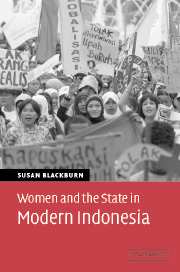Book contents
- Frontmatter
- Contents
- Acknowledgments
- Note on spelling and terminology
- Glossary: abbreviations, acronyms and Indonesian terms
- Introduction
- 1 State gender ideologies and the women's movement
- 2 Education
- 3 Early marriage
- 4 Citizenship
- 5 Polygamy
- 6 Motherhood
- 7 Economic exploitation
- 8 Violence
- Conclusion
- References
- Index
Introduction
Published online by Cambridge University Press: 22 September 2009
- Frontmatter
- Contents
- Acknowledgments
- Note on spelling and terminology
- Glossary: abbreviations, acronyms and Indonesian terms
- Introduction
- 1 State gender ideologies and the women's movement
- 2 Education
- 3 Early marriage
- 4 Citizenship
- 5 Polygamy
- 6 Motherhood
- 7 Economic exploitation
- 8 Violence
- Conclusion
- References
- Index
Summary
During the New Order regime in Indonesia (1967–98), political life was entirely oriented towards the state. Women were affected as much as men. Whether or not it was possible for women's organisations to work on issues they considered important, and how successful they might be in such endeavours, depended heavily on whether the state looked upon them favourably. Then, in the space of only a few months, with the fall of President Suharto, the nature of political life changed dramatically, as the state grew weaker and civil society flourished in all kinds of admirable and repulsive ways – a mixture of mushrooms and toadstools bursting out of the debris of the authoritarian state. In 2001 the first Indonesian woman president took office, something unthinkable under the military-dominated New Order. Freedom of association was enjoyed by women and men, but women in particular soon began to feel the lack of state services and control of law and order. Sudden changes like these focus attention on the importance of the state for women.
This book investigates how the state and Indonesian women have engaged with one another over the past century. Because the state is such an important institution in people's lives, Indonesian women have had to come to terms with it. How have they done this, and with what results? How has the state responded and how has it sought to influence women?
Analysing the state's engagement with women is always a difficult task.
- Type
- Chapter
- Information
- Women and the State in Modern Indonesia , pp. 1 - 7Publisher: Cambridge University PressPrint publication year: 2004

